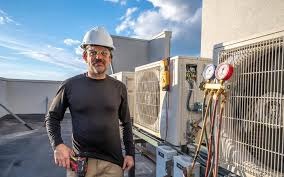Solar systems have evolved a lot during the past years. Solar systems have not only facilitated people for their daily uses but it has also made the operations of businesses easy by facilitating them with the most efficient and less expensive source of energy.

The main difference between a residential and a commercial solar system is the capacity. The residential solar systems are obviously smaller in size and capacity while the needs of businesses are large and so is the required capacity of a commercial solar system. Space is also not an issue for businesses. Therefore they can afford to have large scale solar systems with more panels according to their energy needs. This is also the reason why commercial solar systems are more efficient as compared to residential solar systems.
Types of Commercial Solar Systems
Keeping in view the varying needs of companies and businesses, the solar system producing companies now offer many different types of commercial solar systems. Some of the most important types are given below.
Carports
This idea is unique and new but it seems to be a very intelligent way of utilising the car parking spaces. The solar carport systems offer to utilise the large car parking areas in the best possible way. These carport systems work on the principle of producing energy while providing space and cover for the parked cars. This is a great option for business owners who do not have enough roof space for the installation of commercial solar panels. Carports are a very simple yet economic way for the production of solar power. This option is also suitable for those who have already mounted panels on the rooftop and now want to add more panels but have not left any space on the roof. Solar panels on the carport structures are also easy to install, maintain and clean.
Flat Rooftop Systems
Flat rooftop systems of commercial solar are of three main types. One is called attached, other is known as ballasted and the third one is the hybrid one which is the combination of the first two. The business owners can choose between the above three types according to their roof style, architecture of the building and engineering analysis of the building structure.
- Attached System: this system is designed in a way that it is penetrated in the surface of the roof. The connections are then made with the framing of panels.
- Ballasted System: this system is mostly weight dependent. A ballasted system is dependent on the total weight of the panels, racking and other parts. It is designed to hold the array of all parts in the downward direction.
- Hybrid System: this system is a combination of penetrations and ballasting used to mount the panels.
Slanted Rooftop Systems
Business owners with slanted rooftops once thought it impossible to install the solar panels. However different building structures have made it a necessity to modify the solar systems to accommodate different roof types. Slanted rooftop systems are another example. Slanted rooftops are not eligible to install solar panels as there is a risk involved in such rooftops. However with the advancement in solar panel building technology, it is not impossible now. Attached systems are used to install solar panels on slanted rooftops. The panels are penetrated onto the roof surface to give them a tight hold and decrease the risk of falling. They are mounted at an angle to get maximum light from the sun.
Ground Mounted Systems
The business owners who have small rooftops or less space left on rooftops for mounting the solar panels, can take advantage of the ground systems. These systems are mounted on the ground by setting the angle of panels in an efficient way to get the most light from the sun. There are two types of ground mounted systems. One is the standard ground mount in which the panels are fixed in the ground at a certain angle. The other type is known as the pole mounts. The pole mounts have a structure to raise the panels up from the ground to get the maximum light from the sun. They also have tracking systems to tilt towards the light of the sun.
Tracker Systems
Tracker systems are used to increase the energy production capacity of a commercial solar system. Tracking system lets the business owners get the maximum kilowatts possible in an hour. The tracker targets the light of the sun and moves along the axis with the movement of light. However tracker systems are more expensive as compared to other commercial solar systems. Their maintenance and installation costs are also high. Tracker systems are also less popular with the business owners as compared to the fixed commercial solar systems with no moving parts. The credibility of these systems is also doubtful.
Concluding Comments
Business owners can utilise the commercial solar systems in many ways. The most important thing is that they can save a great amount of money on the utility bills and consequently, this will help in reducing the operating costs of the business. The grid ties commercial solar systems are also another great option for businesses to save money. If you plan to install a grid-tied solar panel system for your business in Texas, you can check out this page for the best texas electric rate plans.




